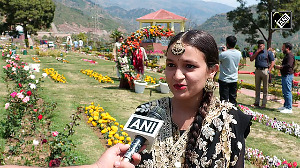With an investment of Rs 12 crore (Rs 120 million), this bank is a joint venture between Asia Cryo Cell Pvt Ltd and Florida based Cryo-Cell International.
Under the license agreement, CCI will share technical knowledge with Asia Cryo-Cell. The facility is currently available only to those residing in Chennai. CCI, with a track record of 12 years, have been pioneers in umbilical cord stem cell banking.
The company plans to set up two franchisee centres in Hyderabad and Bangalore by the end of this year. In the next two years, 24 such banks will be established all over India.
What are stem cells?
Stem cells are the master cells responsible for producing all the mature cells in our blood and immune system.
It contains white blood corpuscles that fight infection, red blood corpuscles that carry oxygen, and platelets that promote clotting and the cells of our immune system.
Stem cells that are found in abundance in bone marrow have the ability toregenerate into other types of cells in the body.
The use of stem cells from embryos for research has resulted in a lot of debates and controversies raging all over the world. It had resulted in a heated debate recently between the two American presidential candidates, George Bush and John Kerry.
But it is not only from embryos that stem cells can be gathered and used. There are three sources from which stem cells can be derived- embryonic, adult and umbilical cord.
Lifesaving umbilical cord stem cells
The umbilical cord, connecting the foetus with the mother is cut at the time of delivery and discarded. Cord blood (the remaining blood in the umbilical cord) is full of 'stem cells' which is the origin of the body's immune and blood system.
In the 1970's, medical researchers discovered that human umbilical cord blood contained the same kind of stem cells found in bone marrow. Because stem cells from bone marrow had already been used to treat patients suffering from diseases like leukaemia and other immune system disorders, researchers believed that they could also use stem cells from umbilical cord blood to save patients.
In 1988, umbilical cord stem cells were first used for transplantation on a 5-year old boy suffering from Fanconi's anaemia in France. The boy was cured of the disease and is still alive.
Based on this and other successful transplants, doctors and medical researchers began to collect, freeze and store cord blood units at cord banks throughout the world to treat several ailments and save lives.
More than 45 diseases have now been treated using cord blood cells. These include malignant diseases like leukaemia, lymphoma, neuroblastoma and retinoblastoma, and several other non-malignant diseases as well.
The non-malignant diseases are primarily inherited disorders of the blood and immune systems, or are genetic diseases affecting metabolism.
Research is also going on to treat diseases like stroke, Alzheimer's, multiplesclerosis, lupus and diabetes by transplanting cord blood stem cells.
A bank for cord blood stem cells
Cord stem cell preservation consists of collecting the 'leftover' umbilical cord blood from the placenta and umbilical cord after the baby is delivered and the cord is cut.
This blood is sent to a bank where it is processed and preserved by freezing them in liquid nitrogen at a temperature of -195 degree celsius.
Many clinical studies showed that unrelated cord blood transplantation is safe and is an acceptable alternative to bone marrow transplantation for many patients. However, the studies also found that, as with bone marrow transplants, patients who receive cord blood from siblings or related donors generally have higher survival rates than those who receive cord blood from unrelated donors.
Researchers say that collecting and preserving a baby's cord blood stem cells would be a security blanket for the baby and his family members. In fact, it is estimated that the probability of a need for cord blood stem cells arising within a family is as high as 1/1,500.
Cord stem cell bank in India
In this backdrop, the launch of a cord stem cell private bank in India assumes great significance.
According to Dr Saranya, medical director of 'Lifecell', parents who are expecting a baby can register with the organisation by paying a one time fee of Rs 59,900.
The family can preserve the cord blood cells from the umbilical cord for 21 years at the private bank, 'Lifecell'. Alternatively, they can pay a sum of Rs 29,000 and a yearly fee of Rs 2,900 for storing the cells for 21 years.
Out of the 100 cord blood stem cells banks all over the world, 75 are public banks. Dr Shanta, director of the Adyar Cancer Institute urged Asia Cryo-Cell not to restrict their activities to private members alone. "There are thousands of people in India, mainly among the poor, who need such transplants. If the cord blood stem cell bank is of no use to such people and if organisations restrict their activities only to private citizens, what is the use of technology coming to India?" Dr Shanta asks.
The company assures that it would to open a public stem bank in the near future. "Talks are on between Asia Cryo Cell and CCI, Florida to start a public cord blood stem cells bank which would serve the needy," says vice-chairman of Asia Cryo Cell, Abhaya Kumar said.
If the public cord blood stem cell bank becomes a reality, it would save the lives of many patients in India.





 © 2025
© 2025